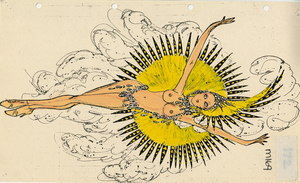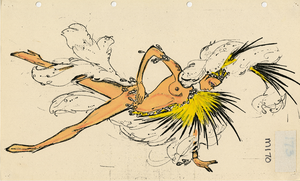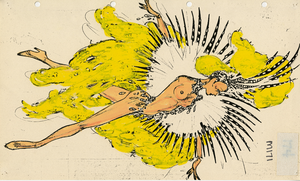Search the Special Collections and Archives Portal
Search Results

Costume design drawing, topless showgirl in yellow and black feathers #8, Las Vegas, June 5, 1980
Date
1980-06-05
Archival Collection
Description
Pete Menefee design. Transcribed from original drawing index: "tall nude girl (yellow & black feathers #8)."
Costume Details: Topless showgirl in jeweled g-string and headress with yellow, white, and black feathers.
Show Name: Jubilee!
Performance Name: Minstrel opening: Hullabaloo
Site Name: MGM Grand Hotel and Casino
Costume Details: Topless showgirl in jeweled g-string and headress with yellow, white, and black feathers.
Show Name: Jubilee!
Performance Name: Minstrel opening: Hullabaloo
Site Name: MGM Grand Hotel and Casino
Image

Costume design drawing, topless showgirl in yellow and black feathers #9, Las Vegas, June 5, 1980
Date
1980-06-05
Archival Collection
Description
Pete Menefee design. Transcribed from original drawing index: "tall nude girl (yellow & black feathers #9)."
Costume Details: Topless showgirl in jeweled g-string and headress with yellow, white, and black feathers.
Show Name: Jubilee!
Performance Name: Minstrel opening: Hullabaloo
Site Name: MGM Grand Hotel and Casino
Costume Details: Topless showgirl in jeweled g-string and headress with yellow, white, and black feathers.
Show Name: Jubilee!
Performance Name: Minstrel opening: Hullabaloo
Site Name: MGM Grand Hotel and Casino
Image

Costume design drawing, topless showgirl in yellow and black feathers #10, Las Vegas, June 5, 1980
Date
1980-06-05
Archival Collection
Description
Pete Menefee design. Transcribed from original drawing index: "tall nude girl (yellow & black feathers #10)."
Costume Details: Topless showgirl in jeweled g-string and headress with yellow, white, and black feathers.
Show Name: Jubilee!
Performance Name: Minstrel opening: Hullabaloo
Site Name: MGM Grand Hotel and Casino
Costume Details: Topless showgirl in jeweled g-string and headress with yellow, white, and black feathers.
Show Name: Jubilee!
Performance Name: Minstrel opening: Hullabaloo
Site Name: MGM Grand Hotel and Casino
Image

Costume design drawing,topless showgirl in yellow and black feathers #11, Las Vegas, June 5, 1980
Date
1980-06-05
Archival Collection
Description
Pete Menefee design. Transcribed from original drawing index: "tall nude girl (yellow & black feathers #11)."
Costume Details: Topless showgirl in jeweled g-string and headress with yellow, white, and black feathers.
Show Name: Jubilee!
Performance Name: Minstrel opening: Hullabaloo
Site Name: MGM Grand Hotel and Casino
Costume Details: Topless showgirl in jeweled g-string and headress with yellow, white, and black feathers.
Show Name: Jubilee!
Performance Name: Minstrel opening: Hullabaloo
Site Name: MGM Grand Hotel and Casino
Image

Costume design drawing,topless showgirl in yellow and black feathers #12, Las Vegas, June 5, 1980
Date
1980-06-05
Archival Collection
Description
Pete Menefee design. Transcribed from original drawing index: "tall nude girl (yellow & black feathers #12)."
Costume Details: Topless showgirl in jeweled g-string and headress with yellow, white, and black feathers.
Show Name: Jubilee!
Performance Name: Minstrel opening: Hullabaloo
Site Name: MGM Grand Hotel and Casino
Costume Details: Topless showgirl in jeweled g-string and headress with yellow, white, and black feathers.
Show Name: Jubilee!
Performance Name: Minstrel opening: Hullabaloo
Site Name: MGM Grand Hotel and Casino
Image

Costume design drawing, topless showgirl in yellow and black feathers #13, Las Vegas, June 5, 1980
Date
1980-06-05
Archival Collection
Description
Pete Menefee design. Transcribed from original drawing index: "tall nude girl (yellow & black feathers #13)."
Costume Details: Topless showgirl in jeweled g-string and headress with yellow, white, and black feathers.
Show Name: Jubilee!
Performance Name: Minstrel opening: Hullabaloo
Site Name: MGM Grand Hotel and Casino
Costume Details: Topless showgirl in jeweled g-string and headress with yellow, white, and black feathers.
Show Name: Jubilee!
Performance Name: Minstrel opening: Hullabaloo
Site Name: MGM Grand Hotel and Casino
Image

Costume design drawing,topless showgirl in yellow and black feathers #14, Las Vegas, June 5, 1980
Date
1980-06-05
Archival Collection
Description
Pete Menefee design. Transcribed from original drawing index: "tall nude girl (yellow & black feathers #14)."
Costume Details: Topless showgirl in jeweled g-string and headress with yellow, white, and black feathers.
Show Name: Jubilee!
Performance Name: Minstrel opening: Hullabaloo
Site Name: MGM Grand Hotel and Casino
Costume Details: Topless showgirl in jeweled g-string and headress with yellow, white, and black feathers.
Show Name: Jubilee!
Performance Name: Minstrel opening: Hullabaloo
Site Name: MGM Grand Hotel and Casino
Image

Costume design drawing, male dancer in silver tights and vest, Las Vegas, June 5, 1980
Date
1980-06-05
Archival Collection
Description
Pete Menefee design. Handwritten on drawing: "disco boy dancers." Transcribed from original drawing index: "16 boy dancers (silver tights, vests- disco)."
Costume Details: Male dancer wearing silver tights and rhinestone-studded boots, wrist cuffs, g-string, and vest.
Show Name: Jubilee!
Performance Name: Minstrel opening: Hullabaloo
Site Name: MGM Grand Hotel and Casino
Costume Details: Male dancer wearing silver tights and rhinestone-studded boots, wrist cuffs, g-string, and vest.
Show Name: Jubilee!
Performance Name: Minstrel opening: Hullabaloo
Site Name: MGM Grand Hotel and Casino
Image

Costume design drawing,male dancer in black tights and dog collar, Las Vegas, June 5, 1980
Date
1980-06-05
Archival Collection
Description
Pete Menefee design. Transcribed from original drawing index: "2 principal boy dancers (disco nudes)."
Costume Details: Male dancer wearing black tights and rhinestone-studded boots, wrist cuffs, g-string, and dog collar/vest combination.
Show Name: Jubilee!
Performance Name: Minstrel opening: Hullabaloo
Site Name: MGM Grand Hotel and Casino
Costume Details: Male dancer wearing black tights and rhinestone-studded boots, wrist cuffs, g-string, and dog collar/vest combination.
Show Name: Jubilee!
Performance Name: Minstrel opening: Hullabaloo
Site Name: MGM Grand Hotel and Casino
Image

Costume design drawing, topless showgirl in yellow and black feathers #16, Las Vegas, June 5, 1980
Date
1980-06-05
Archival Collection
Description
Pete Menefee design. Transcribed from original drawing index: "tall nude showgirl (yellow & black feathers #16)."
Costume Details: Topless showgirl in jeweled g-string and headress with yellow, white, and black feathers.
Show Name: Jubilee!
Performance Name: Minstrel opening: Hullabaloo
Site Name: MGM Grand Hotel and Casino
Costume Details: Topless showgirl in jeweled g-string and headress with yellow, white, and black feathers.
Show Name: Jubilee!
Performance Name: Minstrel opening: Hullabaloo
Site Name: MGM Grand Hotel and Casino
Image
Pagination
Refine my results
Content Type
Creator or Contributor
Subject
Archival Collection
Digital Project
Resource Type
Year
Material Type
Place
Language
Records Classification
